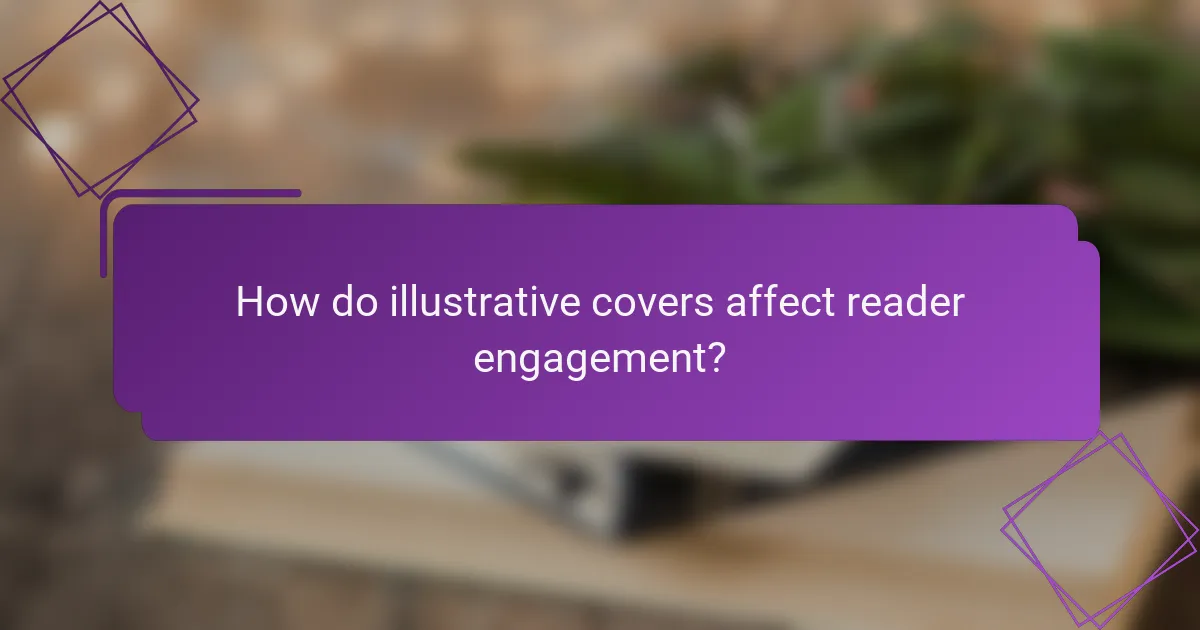The choice between illustrative and photographic covers plays a crucial role in reader engagement, influencing how potential readers connect with a book. Illustrative covers often evoke curiosity and emotional resonance, while photographic designs can create immediate connections through relatable imagery. Understanding these dynamics can help authors and publishers make informed decisions that enhance their book’s appeal and marketability.

How do illustrative covers affect reader engagement?
Illustrative covers can significantly enhance reader engagement by creating a unique visual narrative that resonates emotionally with potential readers. These covers often evoke curiosity and imagination, drawing readers in more effectively than traditional photographic designs.
Enhanced emotional connection
Illustrative covers often convey emotions and themes that resonate deeply with readers, allowing for a more personal connection. For example, a whimsical illustration might evoke nostalgia, while a dark, moody design could suggest suspense or intrigue. This emotional engagement can lead to a stronger desire to explore the content within.
Consider how a children’s book with a vibrant, hand-drawn cover can attract young readers and their parents, compared to a standard photograph. The illustration not only captures attention but also sets the tone for the story, creating an immediate bond.
Unique visual appeal
Illustrative covers stand out in a crowded market, offering a distinctive visual appeal that can capture attention more effectively than photographs. They allow for creative expression that can reflect the book’s themes in ways that photographs may not convey as vividly.
For instance, an illustrated cover can incorporate fantastical elements that align with the story’s genre, making it memorable. This uniqueness can be a deciding factor for readers browsing through numerous titles, as it differentiates the book from others on the shelf.
Targeted audience attraction
Illustrative covers can be tailored to attract specific audiences by reflecting their interests and preferences. For example, a cover designed for a young adult fantasy novel might feature bold colors and imaginative characters, appealing directly to that demographic.
Understanding the target audience is crucial; using illustrations that resonate with their tastes can enhance engagement. For instance, a romance novel might use soft, pastel illustrations to attract readers looking for a light-hearted escape, while a thriller could opt for darker, more intense visuals to draw in suspense lovers.

What impact do photographic covers have on reader engagement?
Photographic covers significantly enhance reader engagement by providing a visual representation that resonates with potential readers. These covers can create an immediate emotional connection, making the content more appealing and relatable.
Realistic representation of content
Photographic covers offer a tangible glimpse into the book’s themes and subjects, allowing readers to visualize the content. This realistic representation can draw in readers who prefer authenticity over abstract illustrations. For example, a novel featuring a cityscape photograph may attract urban fiction enthusiasts more effectively than a stylized graphic.
Familiarity and relatability
Using photographs can evoke familiarity and relatability, which are crucial for engaging readers. When potential readers see images that reflect their own experiences or environments, they are more likely to feel a connection to the material. A cover depicting a family gathering can resonate with readers seeking relatable narratives about family dynamics.
Professional aesthetic
Photographic covers often convey a professional aesthetic that can enhance the perceived quality of the book. A well-composed photograph can suggest a higher production value, making readers more inclined to trust the content. However, it’s essential to ensure that the photography aligns with the book’s genre; for instance, a sleek, modern cover may suit a contemporary thriller better than a whimsical image.

Which cover style leads to higher sales?
Illustrative covers often lead to higher sales in niche genres, while photographic covers tend to attract a broader audience in mainstream markets. The choice of cover style can significantly impact reader engagement and purchasing decisions.
Illustrative covers for niche genres
Illustrative covers are particularly effective for niche genres such as fantasy, science fiction, and young adult literature. These covers can convey unique themes and imaginative elements that resonate with specific audiences, making them more appealing to targeted readers.
When designing an illustrative cover, consider using vibrant colors and distinctive artwork that captures the essence of the story. This approach can create a strong emotional connection and enhance the book’s visibility within its genre.
Photographic covers for mainstream appeal
Photographic covers generally cater to mainstream genres like romance, thrillers, and non-fiction. They often feature relatable imagery that connects with a wide audience, making them more likely to attract casual readers browsing in bookstores or online.
To maximize the effectiveness of a photographic cover, choose high-quality images that reflect the book’s content and tone. A well-composed photograph can evoke curiosity and draw potential readers in, increasing the likelihood of a purchase.
Case studies of bestselling books
Analyzing bestselling books reveals trends in cover styles that correlate with sales success. For instance, many popular fantasy series utilize illustrative covers to create a distinct brand identity, while bestsellers in the romance genre often feature photographic covers that highlight emotional connections.
Examples include the “Harry Potter” series, which employs illustrative artwork that appeals to its fantasy audience, versus “The Notebook,” which uses a photographic cover to evoke a romantic feel. These choices reflect how cover styles can align with reader expectations and genre conventions, ultimately influencing sales outcomes.

What factors influence cover design choices?
Cover design choices are influenced by various factors including genre expectations, target demographic preferences, and current market trends. Understanding these elements helps in creating a cover that resonates with potential readers and enhances engagement.
Genre expectations
Different genres have distinct visual styles that readers anticipate. For instance, romance novels often feature soft colors and images of couples, while thrillers might use darker tones and bold typography to evoke suspense. Aligning the cover design with these expectations can significantly impact a book’s appeal.
When designing a cover, consider the conventions of the genre. Research popular titles in the same category to identify common themes and styles. This can guide your design choices and ensure that your cover meets reader expectations.
Target demographic preferences
Understanding the preferences of your target demographic is crucial for effective cover design. Factors such as age, gender, and cultural background can influence what visuals and colors resonate with potential readers. For example, younger audiences may prefer vibrant, modern designs, while older readers might favor classic aesthetics.
Conduct surveys or focus groups to gather insights on what appeals to your specific audience. Tailoring your cover to reflect their tastes can enhance engagement and increase the likelihood of purchase.
Market trends analysis
Staying informed about market trends is essential for creating a competitive cover design. Trends can shift rapidly, influenced by popular media, social movements, or emerging artistic styles. For example, minimalist designs have gained popularity across various genres, emphasizing simplicity and clarity.
Regularly analyze bestsellers and industry reports to identify current trends. Use this information to inform your design choices, ensuring your cover feels contemporary and relevant. However, balance trendiness with originality to avoid blending in with the crowd.

How can authors test cover designs for effectiveness?
Authors can test cover designs for effectiveness by utilizing various methods such as A/B testing, reader surveys, and analyzing sales data. These approaches provide insights into which cover resonates more with the target audience, ultimately influencing reader engagement and purchase decisions.
A/B testing on social media
A/B testing on social media involves creating two versions of a cover and sharing them with different segments of your audience. By tracking engagement metrics like clicks, shares, and comments, authors can determine which design performs better. This method is particularly effective because it leverages platforms where readers are already active, providing immediate feedback.
When conducting A/B tests, consider running the tests for a sufficient duration to gather meaningful data, typically one to two weeks. Ensure that the audience segments are similar in demographics to avoid skewed results.
Reader surveys and feedback
Reader surveys and feedback can be collected through platforms like Google Forms or SurveyMonkey. Authors can ask specific questions about cover preferences and the emotional response elicited by each design. This qualitative data can provide deeper insights into reader perceptions and preferences.
To maximize response rates, keep surveys short and focused, ideally under 10 questions. Offering a small incentive, such as a discount on the book, can also encourage participation.
Sales data comparison
Analyzing sales data comparison between different cover designs can reveal which version drives more purchases. Authors should track sales figures over time after launching a new cover to see if there is a noticeable increase in sales. Comparing sales data before and after a cover change can provide concrete evidence of a design’s effectiveness.
Consider using tools like Amazon KDP reports or other sales tracking software to gather and analyze this data. Look for trends over several months to account for seasonal fluctuations in book sales.

What are the emerging trends in book cover design?
Emerging trends in book cover design reflect a shift towards more engaging and interactive elements, blending traditional and modern techniques. This evolution includes the use of hybrid styles and innovative technologies that enhance reader interaction and visual appeal.
Hybrid styles combining both approaches
Hybrid styles in book cover design merge illustrative and photographic elements to create visually striking covers. This approach allows designers to leverage the emotional impact of illustrations while incorporating the realism of photographs, appealing to a broader audience.
For example, a cover might feature a photographic background with illustrated characters or elements overlaying it. This combination can enhance storytelling by visually representing themes and moods, making the book more enticing to potential readers.
Interactive and augmented reality covers
Interactive and augmented reality (AR) covers are gaining traction as technology advances. These covers often include QR codes or AR markers that, when scanned with a smartphone, reveal additional content such as animations, videos, or interactive elements that deepen the reader’s experience.
For instance, a book cover might come to life with a short animated sequence that introduces the main character or setting. This innovative approach not only attracts attention but also encourages readers to engage with the book before even opening it, potentially increasing sales and reader loyalty.

